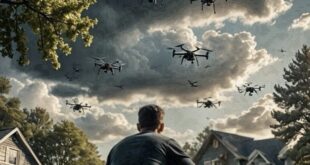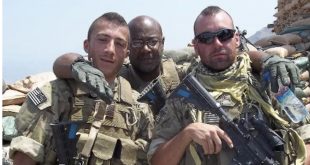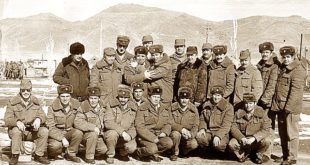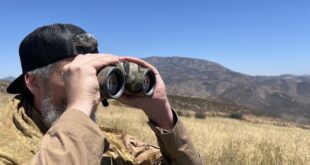By Dr. Martin Brass
From the January 2008 issue of SOF
In the last four of a five part series on the American merc who had the most impact of any American in the decade-long El Salvador war, SOF chronicled the adventures of Harry Claflin.
SOF launched Harry’s wild career in the jungles of the small South American country rocked by riots, coups, wars, and earthquakes.
In the last part, Harry’s picture appeared on the cover of Newsweek Magazine in November, 1986, blowing the lid off the covert operations the Americans were in the thick of with the El Salvadoran government. Operatives of the CIA and other agencies were carrying on clandestine activities in El Salvador, in an effort to help the government fight off the Communist insurgents–the Farabundo Martí National Liberation Front (FMLN). The infamous Iran Contra affair grew legs.
Harry was quickly ordered out of the country. As if that would make the whole scandal or the war disappear.
 OUT OF EXILE
OUT OF EXILE
“It was Christmas, 1986, the first year I had spent the New Year at home in six years.
“In 1987, I got a call from the MilGroup.
“Hey, you want to come back to work?
“Sure, why not.” I packed my gear and went back to Ilopango.
“The American Brigade Operational Planning and Assistance Training Team (OPATT) were starting their own Groupos Operationes Especiales (GOE) projects. They had seen this was a viable concept. A similar program in Santa Anna was very successful.
“So focused on it gave them significant capability within the 55-man limit imposed by Congress. They could pull the brightest and most experienced out of the brigade, equip them and send them out.
“By 1987, U.S. Special Operations Command (USSOCOM) was building the Provisional Reconnaissance Team. They knew they could not come down to the company, platoon, or squad level of training, but with the resources and manpower, they could train small teams and give battalion commanders a great tool.
“The SF decided to train company sized units that were to be the strike force for each Brigade. The El Salvador Commanders thought they were GOE and tried to use them as such. It didn’t work very well. Only in the 4th Brigade with Mike Sheehan, who set up the first unit, did it work like it was supposed.
“I showed them that they could take a bunch of guys, organize them into a 28-man team of five sections–a command group, and four action teams. The command group would consist of one lieutenant, one sergeant, one radio operator, and one medic. Each of the four action teams consisted of a team leader, assistant team leader, radio operator, machine gunner, grenadier, and one sniper.
“Once SOCOM saw this was the way to go, I changed the way the war was fought down there.”
 A MERC IN ADVISOR’S CLOTHING
A MERC IN ADVISOR’S CLOTHING
“In ’87, I stayed with the airborne. I was retraining with the recon platoon and the different companies through ‘88 and setting up different Forward Air Control programs. So, I fell into the routine of running classes on night vision goggles, lasers, night vision scopes, and training sergeants. I worked on establishing security at Comolapa Air Base where the fixed wing assets were shifted.
“Then I would come back to Ilopango where they had something else for me to do, whether it was setting up pistol training courses for pilots, training programs or training with night vision scopes. Basically, I became an American advisor.
“By 1988, the Salvadoran Army had obtained superiority over the rebels, who still controlled nearly one third of the country. The war had virtually ground to a stop, and the guerillas were not really active. Everybody was worn out. No one wanted to be the last statistic.”
ELECTIONS END THE WAR–BRIEFLY
Meanwhile, no one seemed to notice that the guerillas were amassing huge stocks of weaponry, preparing for a final roll of the dice, refusing to give up on overthrowing the ARENA (National Republican Alliance) government that had been elected in an atmosphere of violence the previous March.
“Did the Salvadorian military have any indication as to how the guerillas were able to move all the arms positioned in the city before the offensive?” RKB asked.
“The guerillas positioned the arms a little at a time. They had 24 months to bring this stuff in from Nicaragua,” Harry replied. “Most of it came in through the remote areas on the Salvadoran-Honduran border. There was a large cache by the time it was all smuggled in.”
(Across the world, along with tens of thousands of Germans and anyone else who could hop a plane or train in time, I was witnessing one of the most exciting events in history as it unfolded. It was a bitter cold day, 9 November 1989, and the eyes of the world were on the Berlin Wall as it came crumbling down, signifying the victorious end of the long Cold War—the war in El Salvador had become a distant blur– author’s note).
Two days later, FMLN’s last-gasp offensive caught the military off guard.
 SALVADORAN TET
SALVADORAN TET
“On 11 November 1989, the FMLN launched a surprise offensive against military and civilian targets across the nation, especially in San Salvador, San Miguel, and Santa Ana. This was almost a re-make of the famous “Tet” offensive, undertaken by Viet Cong and North Vietnamese forces in South Vietnam, in 1968 – especially because of the surprise factor and a real shock this large-scale attack caused,” the Air Combat Information Group (ACIG) described the offensive.
“…The Ilopango AB was almost overrun during the initial onslaught, the rebels threatening to destroy up to 80 percent of FAS assets. In bitter fighting, the military incurred extensive losses, but the FMLN not only failed to gain its objective, it also sustained a bitter blow from which it would never recover, including 1,773 dead and 1,717 wounded. The FAS suffered one of its most unusual losses during this period of time, when on 18 November an A-37B was hit by a Dragunov rifle round in the cockpit area: the co-pilot was killed, while the pilot ejected safely,” ACIG wrote.
“The rebels remained active through the rest of 1989 and 1990, inflicting over 2,000 casualties on the Salvadoran armed forces and police per annum. Forty helicopters were shot down between 1988 and 1992,” Harry said.
DESPERATION, RECKLESSNESS, AND ATROCITIES
The country was exhausted after a decade of civil war in which 70,000 had died.
The Inter-American Commission on Human Rights focused on the brutality of the final surge in a vicious, bloody war.
“…FMLN members used civilians as shields and obliged them to form corridors; on other occasions FMLN members obstructed the free movement of civilians and even obliged them to set up barricades.
 “The Government reported that members of the FMLN took control of the Hospital Santa Teresa in the city of Zacatecoluca, using explosive to destroy one of the floors of the building and killing a sick soldier.
“The Government reported that members of the FMLN took control of the Hospital Santa Teresa in the city of Zacatecoluca, using explosive to destroy one of the floors of the building and killing a sick soldier.
“Early in the morning of November 16, world public opinion was shaken by the killing of six Jesuit priests, a cook, and her 15-year-old daughter in the Oscar Romero pastoral center of the Universidad Central de América José Simeón Cañas in San Salvador.”
The victims who had been brutally tortured, were allegedly murdered by a death squad tied to the right wing military.
SOF DOESN’T MISS A WAR
“In 1989, RKB called and said he needed me to take some people down to El Salvador, including former Legionnaire Paul Fanshaw, who has worked with SOF since 1984,” Harry continued his saga. “I was going anyway, so I got my ticket paid for. The offensive was four days old by the time we made it down.
“The war was hot and heavy by this time. I called the Ilopango base and they flew us to the base. We had been there about a week, and we had been out with the troops quite a bit.
“This guy had finally made it down to the Sheraton hotel and called out to base and I didn’t know this guys from spit. Col. Hurtado called me over and said, “Do you know this guy?”
“No, he’s from SOF, he wants us to come get him. The guerillas had cut the road between the base and San Salvador. Hurtado said, “I’m not going to ask you to risk troops.”
“‘No, he’s staying at the hotel,’ I said. A few more days went by and he called again and he was real pushy about coming to the base. I said, ‘Look, bud, you can’t come out to the base.
 “Hurtado was listening. I said, ‘Tomorrow, I’ll get you your media credentials, but at the present time I can’t get you on the base. The general has told me that ‘there are two Americans to be on this base and one of them is to be Harry, you can’t come on to the base, thank you and have a good day’.
“Hurtado was listening. I said, ‘Tomorrow, I’ll get you your media credentials, but at the present time I can’t get you on the base. The general has told me that ‘there are two Americans to be on this base and one of them is to be Harry, you can’t come on to the base, thank you and have a good day’.
IS IT A MISSILE–NO IT’S ONLY A KATUSHA!!
“The military had picked up Jennifer Casolo, a 28-year-old American woman accused of being responsible for funneling several million dollars to the guerillas. They called the base and wanted me to come over to the national police headquarters. They didn’t want the embassy in on this. Fanshaw and I, along with seven Salvadoran officers, drove over in the middle of the night. The police had her locked up in the room and they wanted me to read the documents they had gotten from her a few hours earlier. I read them until 0500, and realizing their importance, made copies and kept them for myself.
“Senator [Edward M.] Kennedy threatened to cut off aid to El Salvador if Casolo wasn’t set free. So she was released back to the United States. One of his aides picked her up in a private aircraft,” Harry said.
“One of the officers said, ‘We need to go back to the base’. We flew with Gen. Bastillo, Capt. Castro and the Air Force XO. Bastillo was flaming hot; they had been waiting for us since midnight. They had found a 122 Katusha rocket they thought was some kind of surface-to-air missile.
“I’m looking at this rocket, and I know that is not a surface to air missile. It’s a Katusha rocket.
“Gen. Bastillo said, ‘Harry what is it?’ I said, ‘It’s a Katusha rocket, think of it as being an artillery round. It has a range of about eight to ten miles. It is not designed to shoot airplanes down.”
The Salvadoran military breathed a sign of relief. The FMLN did not have missiles that could take down the FAS planes.
Until a couple weeks later, that is.
“The war was still hot, we were whipped, we went back, got some sleep until sunup, and went back out with the airborne troops again,” Harry continued.
“Then a twin-engine Beech with missiles on it went down and we urgently tried to reach SOF’s office on Castro’s phone.”
 THE BAD GUYS HAVE MISSILES
THE BAD GUYS HAVE MISSILES
“We had been at the base about two weeks when the Sandinistas tried to fly in a plane load of SA-7s. They had hit a head wind and ran out of gas coming into El Salvador and crashed. The plane was overloaded with SA-7s missiles and four men. It just fell out of the sky. We got there just after it crashed. The bodies were still in the plane. One had lived but he ate his gun. He was busted up pretty good from the crash.
“They had their flight plans from Managua to El Salvador in the plane.
“Before that, the FAS assets, other than helicopters, were safe from ground fire. But now the situation changed as the rebels obtained a weapon that could knock down even the AC-47s.
“After the plane crashed, everything was set in motion. The guerillas had surface-to-air missiles! This was serious stuff. The Salvadoran government grounded all aircraft until we could figure out what was going on. I had some knowledge of this missile, but I needed training manuals to brief the pilots on how to evade it. It had been so long since I had done any work with the SA-7, and I had forgotten a lot.
“The MilGroup didn’t have the manual. Captain Castro, a 1977 U.S. Air Force Academy graduate, was the S-2 of the air force.
SOF TO THE RESCUE
“RKB did a significant thing in ‘89. Without SOF and RKB’s help, we could not have gotten the tech manual for the Russian surface-to-air missile, SA-7.
“RKB, thriving on such challenges, shifted into quick action and rounded up a copy of the manual and faxed it all to Castro. This caused some ruffled feathers with the Americans down there because SOF got it before they could get somebody down there.
“We did it and they couldn’t,” Harry said with pride.
“I’m the one that caught the heat on it. I didn’t tell them where I had gotten it. They were just furious that I had. I still never got a real answer from the Air Force Liaison Officer as to why the Air Force dragged their feet.
“It took SOF two hours to fax the manual. Once we got it, I wrote instructions on the SA-7 missile. Capt. Castro watched as I wrote for four hours. Gen. Bastillo and every single pilot on that base went through that course, and when they came out of the class, they thoroughly understood the SA-7 missile, how it worked and how you could avoid it.
“After we briefed them, they started using their aircraft again. No aircraft was lost until the next year.
“So the Salvos would have been grounded for the next three weeks, had they had to rely on the big guns of the U.S. military?” RKB, always loving to jab one in if it was well deserved, chuckled.
“The Salvos developed a ‘U’ shaped piece of pipe that diverted the exhaust gases into the chopper’s rotor blades to disperse the heat. Since it was a heat-seeking missile, disperse the heat and it could not lock onto the chopper. This missile system took four to six seconds for its heat-seeking mechanism to lock on, so you had to fly at ground level. The guy with the missile did not have time to lock on. If the chopper was at an altitude that gave him time to lock on, you were screwed.
“Teleferico Mountain overlooked Ilopango air base. The guerillas were looking down at the air base. They could fire down at the top of a helicopter.
“You’re going to have to change the pattern of flying out of this base. We had the missile, so I could show them how the launcher worked. For some reason, it really pissed the embassy off,” I told Bastillo.
 WE AND SOF DID IT, AND THEY COULDN’T
WE AND SOF DID IT, AND THEY COULDN’T
“It took the U.S. Air Force three or four weeks to get down there.
“Why, the offensive was over by then?” RKB asked.
“Yea, but the guerillas still had SA-7s and in 1990 they knocked down an AC-47. The missiles didn’t come in until the first phase of the offensive was over,” Harry responded.
A Hughes 500E was shot down on 2 February 1990, followed by Hughes 500D “35”, on 18 May 1990, and an O-2A, on 26 September. The FAS has had an especially problematic November 1990, when the FLMN – despite ongoing negotiations with the government – launched another series of attacks against targets throughout El Salvador, reports ACIG.
On 2 January 1991, the FMLN shot down a UH-1H with three Americans en route from Honduras to provide intel to U.S. advisors in El Salvador: CWO Daniel Scott died in the crash. Lt.Col. David Pickett and Private Ernest Dawson survived, but were brutally executed.
“Two or three of the planes were shot down with surface-to-air missiles that were more sophisticated than a SA-7,” Harry said.
“The military was able to employ air assets all over the country. If SOF and RKB had not provided the SA-7 manual, when they did, it would have given the guerillas another three weeks without aircraft attacking them.
THE DAY EL SALVADOR ALMOST BOMBED MANAGUA
“After the twin-engine Beech crashed with the missiles, the Salvadorian military was enraged. It proved that the Communist-backed Sandinistas were sending the SA-7s.
“The Salvadoran military developed a contingency plan to bomb the Sandanista airport in Managua. We were drawing up plans for a week, and the next day it’s gone.”
“Why?” asked RKB, intrigued.
“Maybe the Americans decided it wasn’t feasible,” Harry replied. “Although I don’t know if they found out about it. I was told not to tell the Americans. Maybe the Salvadorians thought it was not feasible. This was a closely guarded secret.”
“What do you recall of the operational plan?” RKB asked.
“They were going to bomb the air base. They had A-37s carrying 500-pound bombs, and they had the AC-47s. They could have ripped it up,” Harry recalled.
THE DAY THE FMLN STORMED THE SHERATON
“What do you recollect about the guerillas taking over the Sheraton Hotel in the upscale San Salvador district of Escalón?” RKB asked.
“You had U. S. advisors, 12 Green Berets, who had headquarters in the same hotel where SOF had a permanent suite. The guerillas came in from the town of Apopa, down the mountain into San Salvador, and stormed the Sheraton.
“The American advisors barricaded themselves in a room, but for some unknown reason, the guerillas never pressed the attack. The siege lasted over two days, but the guerillas never fired up the stairwell. I heard later that the German anti-terrorist team was there and shot the crap out of the guerillas,” Harry said.
The Secretary General of the Organisation of American States (OAS), João Baena Soares, who was also at the hotel, was snuck out by the Salvadoran security. President George H.W. Bush sent down elite Delta Force personnel from Fort Bragg, ready to intervene directly in the Salvadoran civil war for the first time.
They wouldn’t have to. The Catholic church brokered a deal that let the guerrillas slip out, and the U.S. military whisked the Green Berets away in military vehicles.
THE OFFENSIVE TAKES A HEAVY TOLL
Colonel René Emilio Ponce, Chief of the Armed Forces Joint Staff, reported that the body count during the offensive was 446 soldiers dead and 1,228 wounded, and 1,902 guerrillas killed and 1,109 wounded.
“The war dragged on for a couple more years,” Harry said.
“The UN became involved, sending peacekeepers with the army and peacekeepers with the guerillas to make sure they disarmed. Half of the military was demobilized.
“They say 50-80,000 El Salvadorans died,” Harry said, “but I think it was exaggerated. I know that the number of military they said were killed was exaggerated.
THE WAR ENDS FOR HARRY
“I had a significant role in showing a small unit how the war should go; then our Special Forces teams did it on a country-wide level. I had a role in how Salvadorans were trained down there. I did not win the war. I don’t want to minimize what Special Forces people did down there. Without their support, this war would have never have ended up as good as it did.
“Without the American helicopter pilots down there training the Salvadorians how to shoot and how to use the mini gun and the rockets and how to fly, this war could never have turned out the way it did. By far the most important Americans down there were the U.S. Army warrant officer pilots like Rick Lima, Jose Salazar, and Toby Trajos. These gunslingers that came out of Vietnam orchestrated the training.
“The Air Force MilGroup wanted me to talk to the Salvadorians about building a bunker to store their bombs. They were storing them in a tin building right next to the new airstrip. The bombs were armed, with their detonators and fins in. They would just wheel them out, lock them on the A-37s, and go.
“They had built the new airbase down there about 1990. Ilopango had real underground steel and concrete bunkers.
“We were only just beginning to talk about building the bunkers since they said they didn’t have the money. We were in the office. They brought in a cup of coffee and set a Kleenex down on the table. I drew a sketch on it of what the shape and size of the bunkers would look like. Each one would be fifty yards at the bottom and 200 feet tall, and be made of dirt. I didn’t realize I had drawn the plan for the bunker.
“I had gone home for Christmas and I’m flying back into Cuma Lapa and there are these big ass revetments down below. They had build these things based on the Kleenex sketch. They got in gear and put these things together. They basically had used the dimensions I had written down on a napkin.
“Basically what they made was a berm with a hole.
PEOPLE WILL PICK FREEDOM OVER COMMUNISM
“The war was over and it wasn’t any fun any more. They brought in a whole new set of bureaucracies. The UN was trying to dismantle the American involvement and that’s not a pretty thing to see. The bean counters took over.
“The new American SpecOps that came down had not been part of the war. Their job was to shut down MilGroup operations in El Salvador. For the most part they knew nothing about the people who fought the war.
“The election of President Christiani did more to end that war than any thing else.
He was smart enough to see that the FMLN was done but needed a small carrot to end the fighting. In the next Presidential election, the FMLN candidate only got 1 percent of the votes.
“In the end, Christiani’s recognition of the FMLN as a political party was the smartest thing he could have done. It showed the world that given the choice, people will pick freedom over Communism every time.”
 Soldier of Fortune Magazine The Journal of Professional Adventurers
Soldier of Fortune Magazine The Journal of Professional Adventurers





